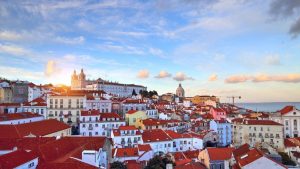
Lisbon is famous for its rich culture, surprising delicacies, year-round sunshine, breathtaking vistas, and historical yellow trams. Lisbon is also known for its bridges over the Tagus River, the vibrant tiled buildings, the gorgeous cork products, the fabulous Fado music, and the Age of Discoveries.
In this article, you’ll discover 33 cool things Lisbon is best known for.
From heart-stopping panoramas to prominent citizens, and from mouthwatering dishes to vivid nightlife, the following lines will help you discover what is Lisbon famous for.
Let’s explore the vibrant Portuguese capital!
✅ Note: This article contains affiliate links. In case you purchase something through one of these links, we may receive a small commission at no extra cost to you. Thank you for helping us keep creating the free content on this website!
The Attractions Lisbon Is Famous For
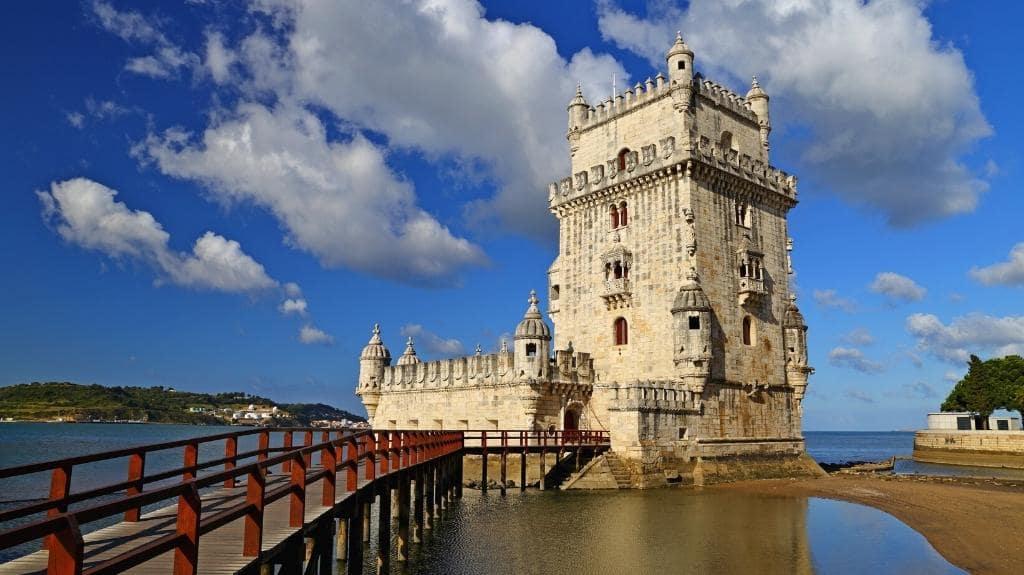
Magnificent monuments, ancient fortifications, and elegant edifices characterize the city on the Tagus River. Below, you’ll discover the main attractions that make Lisbon special.
- Padrão dos Descobrimentos. The Monument of the Discoveries celebrates the maritime explorations of the Portuguese. The impressive landmark raises 171 ft. (52 m) high on the north bank of Tagus River’s estuary. The monument’s shape represents the prow of a caravel with the figure of Henry the Navigator on its edge. Along the ramp, you’ll also see 33 prominent figures from the Age of Discovery. Among them are monarchs, artists, scientists, explorers, cartographers, and missionaries.
- Belém Tower. The medieval fortified tower stands on a small island in the Tagus River. Also known as the Tower of Saint Vincent, it was built in the 16th century. The structure served as a ceremonial gateway to Lisbon. From here, the Portuguese explorers embarked on their adventures. Locals greeted them at the spot after successfully returning from their missions. Nowadays, you can marvel at the jaw-dropping views of the estuary from the rooftop terrace of the tower.
- Sanctuary of Christ the King. The giant monument was inspired by Rio de Janeiro’s Christ the Redeemer. Similar to the Brazilian structure, the Portuguese Christ the King overlooks the city of Lisbon from a hill in the Almada District. The majestic monument stands above the city, turned towards the left bank of the Tagus River. An enormous pedestal supports the 92 ft. (28 m) tall Christ. You can visit the observation deck at the base of the statue and enjoy sweeping views of Lisbon, the Tagus River, and the 25 de Abril Bridge.
- Arco da Rua Augusta. The Rua Augusta Arch is an ornate triumphal arch. Built in 1875, the stone building marks the beginning of the main pedestrian street of Lisbon – Rua Augusta (see more below). Delicate sculptures of historical and mythological figures cover the façade, while six columns support the arch. The coat of arms of Portugal is right in the middle of the structure. For a small fee, you can climb the arch and enjoy fantastic views of the city center.

- Elevador de Santa Justa.The Santa Justa Elevator is one of the most peculiar attractions Lisbon is famous for. The cast-iron lift has been operational since 1899. It boasts intricate ornaments and connects the lower streets of Lisbon’s center with the higher-standing Largo do Carmo. The historic elevator consists of a metal tower, an observation platform, a walkway, and a base. It’s 148 ft. (45 m) high and has seven floors. The tower features two elevator cabins, each with a capacity of 29 people and fantastic views of the area.
- Castelo de São Jorge. São Jorge Castle is a gorgeous hilltop Moorish fortress from the 11th century, offering arguably the best views over the historic center of Lisbon and the Tagus River. On the same spot, different defensive structures have existed since the 1st century BC. The fortification has served as a royal residence since the 12th century. Today, the palace ruins and the onsite archaeological museum are some of the most popular places in Lisbon.
- Jerónimos Monastery. The Hieronymites Monastery is one of the most famous buildings representing the Portuguese Late Gothic Manueline architectural style in Lisbon. You’ll find the UNESCO World Heritage Site in the Belém District. It took 100 years to complete the masterpiece of 16th-century architecture. The monastery boasts complex ornaments featuring maritime elements and items discovered during naval expeditions. Nowadays, the monastery’s wings host an archaeology and a maritime museum.
- Lisbon Cathedral. Sé de Lisboa, also known as the Cathedral of Saint Mary Major, is the most recognizable church in the Portuguese capital. The 12th-century cathedral is in the shape of a Latin cross. During the centuries, earthquakes destroyed it multiple times. The rebuilds resulted in the cathedral’s mix of different architectural styles. The main façade resembles a fortress. Two towers flank the entrance and crenellations peak over the walls. Inside, a series of windows makes the interior beaming with light.

- Teatro Romano de Lisboa. On the south slope of São Jorge Castle, you can explore the excavated ruins of the ancient Roman Theater. Emperor Augustus built the venue in the 1st century and it remained in use for about three centuries. Afterwards, the site was abandoned for ages, until an earthquake in 1755 unveiled the buried theater. Currently, you can visit the onsite museum and see how Romans used to amuse themselves at the beginning of the last millennia.
- Oceanário de Lisboa. The Lisbon Oceanarium is a contemporary aquarium featuring ocean creatures, such as mighty sharks, shy stingrays, vibrant tropical fish, and curious penguins. The aquarium has the largest tank in Europe. You’ll find the incredible structure on the waterfront, on the exhibition grounds of Expo 1998. You can’t miss the impressive edifice, which resembles an airplane landed on a dock in an artificial lake. Tip: If you love exploring marine species and stunning aquariums, we recommend also checking out the L’Oceanogràfic in Valencia and the Aquarium & Underwater Zoo in Dubai.
- Ponte 25 de Abril. The striking suspension bridge over the Tagus River spans for more than 1.4 mi (2.3 km). The impressive red structure is often compared to the Golden Gate Bridge. The 25 de Abril Bridge connects the historic center of Lisbon with the Almada District, where the Sanctuary of Christ the King guards the city. Note, that it’s illegal to cross the bridge on foot! You have to take a tram or a bus to reach the other side of the river. The most spectacular way to marvel at Ponte 25 de Abril is to arrive in Lisbon by ship, as Naddya did in 2019. The experience was unforgettable.
Unique Places That Make Lisbon Special

Now that you know what the top landmarks of the Portuguese capital are, let’s find out which amazing areas create Lisbon’s unique vibe.
- Bairro Alto. The Upper District of Lisbon, as the name translates, is one of the city’s historic districts. Take a stroll through the steep cobbled streets or ride the historic funicular. Admire the centuries-old vibrant houses and enjoy the colorful street art. Take in the romantic vibe and marvel at the views from the most popular viewpoints (see below). After sunset, join the hip crowd for drinks in the quirky bars or fado locales around the neighborhood.
- Alfama. In the area, you can explore some of Lisbon’s most popular attractions. One of our best Lisbon travel tips is to take the historic Tram no. 28 uphill to avoid climbing the steep streets. The tram will take you past the Lisbon Cathedral and all the way up to the São Jorge Castle. From there, you’ll have the most magnificent vistas over Lisbon. Then, get lost in the cobbled alleys of Alfama. Souvenir shops line the streets, selling traditional crafts and serving delicious pastries. The sounds of melancholy fado songs fill the air in the evenings.
- Praça do Comércio. The Commerce Square of Lisbon is one of the largest plazas in Portugal. It faces the harbor and greets passengers arriving by water. The last remodel of the city square took place in the 18th century, after an earthquake destroyed most of the surrounding buildings. Nowadays, several fantastic cultural centers line the square. The most interesting to visit is Lisboa Story Centre. Inside, fun interactive displays tell you about the history of Lisbon and the conquests of the Portuguese. The majestic equestrian statue of Joseph I of Portugal rises in the middle of the plaza, making it a great spot to pose for your travel photos.
- Rua Augusta. Starting near the Praça do Comércio, under the Arco da Rua Augusta, is the most famous pedestrian street of Lisbon. Rua Augusta stretches for about half a mile. Intricate, radiant mosaics cover the street. Outdoor cafés, pastry shops, restaurants, bars, stores, and hotels line its sides. Sit for a bica (coffee) with a traditional pastel de nata or try the local drink ginjinha (more info in the food section). Buy exquisite cork souvenirs or shop for new fashion designs in the boutiques along Rua Augusta.
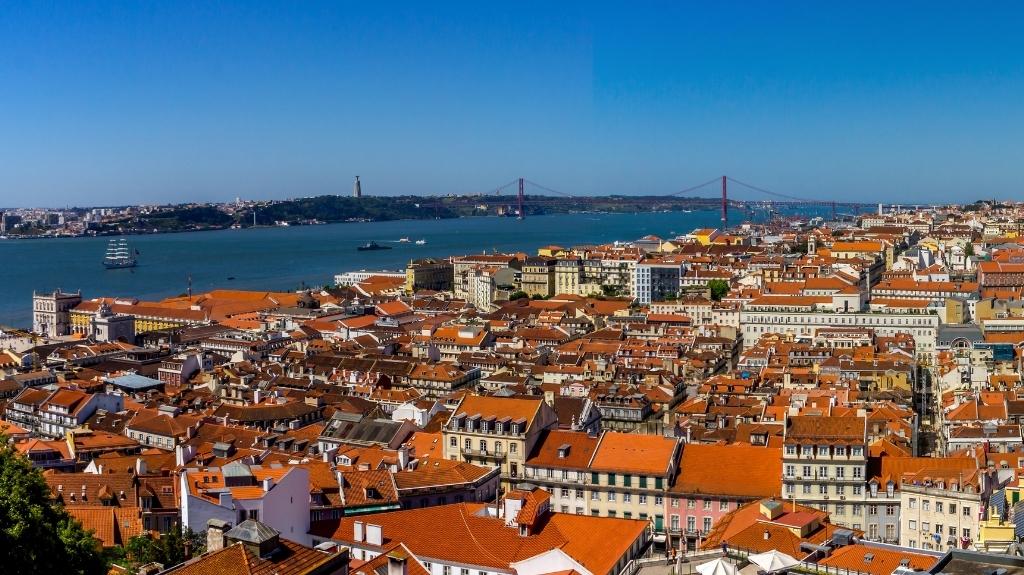
- The breathtaking viewpoints. The hilly terrain of Lisbon means one important thing for travelers – you can marvel at breathtaking views from several great spots in the city! The most famous viewpoints in the Portuguese capital are Miradouro das Portas do Sol, Miradouro do Castelo de São Jorge, and Miradouro de Santa Luzia. The viewpoint at Portas do Sol offers stunning vistas over the traditional red-roofed houses and stone churches of Alfama. The viewing spot at the São Jorge Castle reveals panoramas of the historic center and the ocean. And Santa Luzia’s observation deck will enchant you with sweeping views of Lisbon and the Tagus River.
- The vibrant markets. To suck in the appeal of Lisbon, you have to wander around the markets in the city. Here are the most popular ones:
- Mercado da Baixa. At this open-air market, merchants will seduce you with traditional street food, refreshing beverages, and local produce. Smoked meats, dried fruits, and delectable sweets invite for a degustation.
- Mercado da Figueira. You’ll find fresh produce, local wines, and fragrant spices at this indoor complex of stalls and small shops. Exotic fruits, fresh meat, and an abundance of pastries will excite your senses.
- Mercado da Ribeira. This spacious indoor market offers anything from scrumptious food through live plants to books and antiquities. Taste local delicacies and spirits before going on a treasure hunt among the relics.
- Mercado de Santa Clara. Another treasure trove in Lisbon is the flea market at Campo de Santa Clara. Every Tuesday and Saturday, you can dig through the diverse mix of household, clothing, and antique items to find your style.
- The countless fado locales. No article about the Portuguese capital would be complete without mentioning the most popular music of the country. Fado literally means “fate”. The music style originates from Lisbon and the region. You can learn about its history at Museu do Fado. But to truly experience the unique melody and singing, visit one of the countless bars and restaurants with live performances. The most popular fado locales in Lisbon include Fado & Wine, Sr. Fado, and Duque da Rua. Alternatively, we recommend booking the fantastic show “Fado in Chiado”.
The Most Popular Citizens of Lisbon

From great rulers through famous sailors to important literary figures, below you’ll find the most prominent citizens of Lisbon.
- Isabella of Portugal. Hardly any other person in human history has accumulated more titles and power than the Lisbon-born Isabella of Portugal. At the beginning of the 16th century, she became Queen Consort of Spain and Germany, and Lady of the Netherlands – at age 23. Four years later, she was already Holy Roman Empress and Queen Consort of Italy. She was also the regent of Spain during her husband’s constant absence. Her diplomatic skills secured fruitful alliances with neighboring kingdoms for years to come.
- Vasco da Gama. At the end of the 15th century, the famous navigator concluded his initial voyage to India around the Cape of Good Hope. Linking Europe and Asia via an ocean route marked the beginning of a sea-based global colonization. Da Gama’s discovery of the sea route to India gave the Portuguese an unopposed access to invaluable spice sources. This skyrocketed the country’s economy.
- Francisco de Almeida. Born in Lisbon in a noble family, Francisco de Almeida began his military career at an early age. The sailor and explorer was part of several missions to Asia and Africa. His armada established spice trade routes with India and South Africa. Francisco de Almeida’s conquests secured Portugal’s naval hegemony in the Indian Ocean. He served as the viceroy of Portuguese India but lost his life near the treacherous Cape of Good Hope.
- João II of Portugal. King John II is often called the Perfect Prince. During his ruling, he faced multiple challenges, which he solved brilliantly. Firstly, he managed to consolidate the power of the monarchy. Secondly, facing a bankrupt kingdom, he took wise measures to include a Council of Scholars in the decision-making process. The council consisted of select citizens based on their skills, talents, and credentials. Finally, King John’s renewed explorations of Africa and Asia brought great profits to the country’s treasury.
- Fernando Pessoa. Critics and readers consider the Portuguese poet, writer, and philosopher one of the most important literary figures of the 20th century. Pessoa is famous for creating multiple personalities. He wrote under 75+ names, which he didn’t call pseudonyms. Pessoa believed they had independent intellectual life, so for him these were heteronyms. His creations often expressed unpopular or even extreme views.
The Foods and Drinks Lisbon Is Famous for

The best way to explore the vibrant Portuguese capital is through its flavors. Let’s find out which staple foods and drinks Lisbon is famous for.
- Pastéis de Nata. Naddya’s favorite custard tarts are creamy on the inside and crunchy on the outside. You can order the yellow, egg cream deliciousness in every café, bakery, and pastry shop in Portugal. The recipe is one of the most strictly kept secrets in the country. Some versions feature apples or other fruits in the filling. In Lisbon, the most popular places to satiate your sweet tooth cravings are Fábrica da Nata, Manteigaria, and Alfama Doce.
- Sardines. Grilled or canned, ordering sardinhas in Lisbon is always a good idea. Sardines from the grill come richly doused in olive oil. Around the city, you’ll also see countless shops selling brightly colored tinned sardines. The price ranges are enormous. Expect to pay up to a hundred for the most exquisite cans! If you’re looking for a signature souvenir to bring back from Lisbon, check out the family-owned Conserveira de Lisboa and The Fantastic World Of Portuguese Sardines for their gigantic selection of tins.
- Bifana. The staple Lisboan sandwich is a heavenly creation. It epitomizes thinly sliced, slowly cooked pork meat, a hearty bread roll, and a splash of spicy piri piri sauce or mustard. In this simple trio, you can also taste the white wine, the garlic, and the herbs in which the delicate meat simmered for hours. Many restaurants in Lisbon claim to serve the best bifana, but we suggest you try it at Bifanas do Afonso. We bet you’ll lick your fingers after the feast.
- Chouriço. The famous Portuguese smoked sausage is made of pork, fat, paprika, garlic, and spices. Cumin, cinnamon, white pepper, and piri piri peppers usually flavor the meat. You can eat it in many varieties in Lisbon – on its own or as ingredient in popular stews. However, the best way to enjoy it is by ordering chouriço assado. The dish is prepared directly on your table, over an alcohol flame, in a burning clay pot.
- Ginjinha. The popular Portuguese liqueur features infused in alcohol ginja berries, which are a sour cherry variety. Sugar, cloves, and cinnamon add further flavor to the staple drink. In Lisbon, you can sample it in several specialty bars. The most famous ones include the historic To Ginjinha, the vibrant Ginjinha Sem Rival, and the quirky Ginjinha das Gáveas.
Curious Facts Lisbon Is Known For
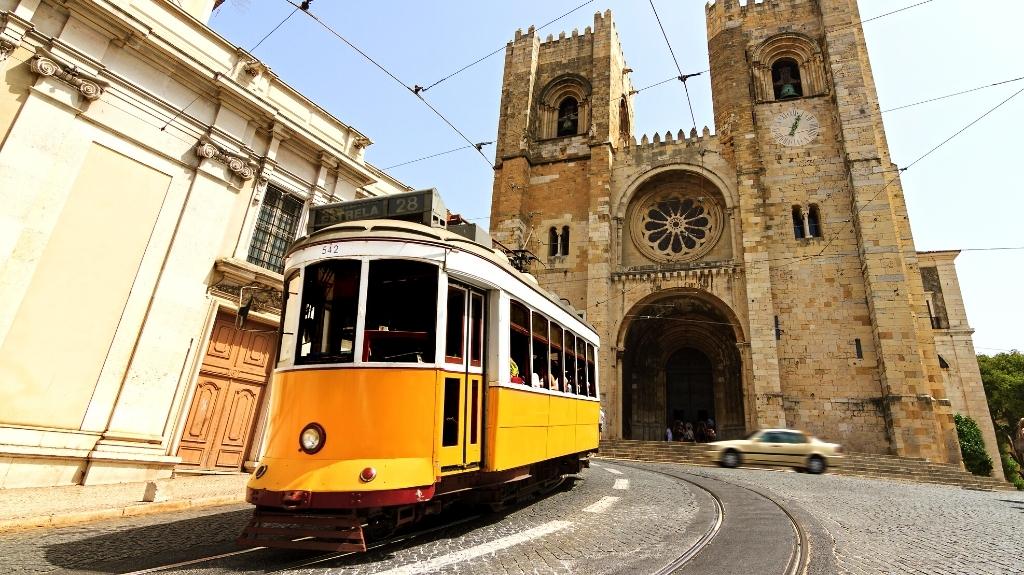
From peculiar vehicles to exclusive souvenirs, these fun facts about Lisbon perfectly explain what makes the city unique.
- Tram 28. The iconic yellow trams are one of the things Lisbon is most famous for. They serve several lines, the most popular being no. 28. The line has been operating since 1914. The tram takes you on a scenic route through the touristic districts of Lisbon. The small, bright car climbs the steep hills and takes the sharp curves with ease. When it approaches the Lisbon Cathedral, you’ll feel like it’ll drive straight through the gates. At the last moment, it’ll swerve and avoid collision. Riding the yellow trams of Lisbon is one of the coolest and most recommended things to do in the Portuguese capital.
- Tuk-Tuks. You wouldn’t expect to find the little vehicles outside South-East Asia. However, they fit right in the steep, narrow, cobbled streets of Lisbon. You’ll see them parked at every corner of the historic center, waiting to take you on an exhilarating adventure around tight corners and sharp hills. You can even call one in advance and navigate the alleys of the Portuguese capital in a unique way. Usually, you book them by the hour and the driver acts as your tour guide.
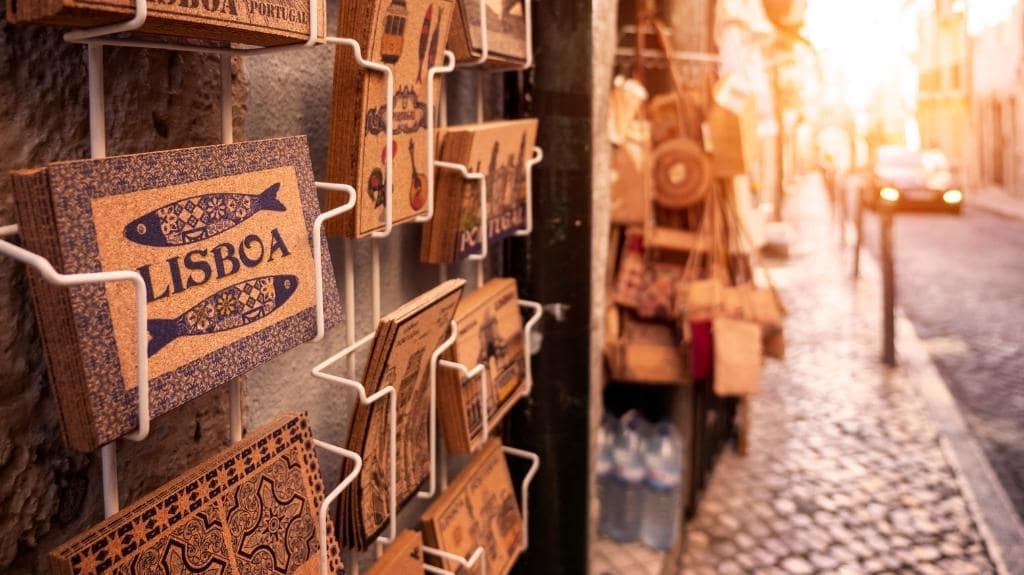
- Cork. The versatile, natural material is harvested from the bark of a species of oak. Around 50% of the world’s cork production comes from Portugal. You’ve probably seen cork stoppers in your wine bottles before, but that’s not the only use for this material. Lisbon is known for its countless souvenir shops and boutiques selling goods made of high-quality cork. The material is light and waterproof, and is an excellent insulator. Whether you buy a fashionable handbag, a unique wallet, a funky belt, a trendy jacket, or a piece of jewelry, we’ll leave the choice to you.
- The Portuguese Riviera. The western neighborhoods of Lisbon’s metro area touch the Atlantic Ocean. You can easily do a day trip from the capital’s center to the beach. At the Portuguese Riviera, check out the sand stretches of Praia da Crismina or Praia do Guincho. The latter is not only famous among surfers, kitesurfers, and windsurfers, but also appeared in a James Bond movie. At the Portuguese Riviera, you can visit the westernmost point of Continental Europe, the dramatic cliffs of Cabo da Roca as well.
- Azulejos. When you walk around Lisbon, you’ll encounter countless buildings covered in richly painted tiles. The ceramic tiles are called azulejos in Portuguese, and you can see them decorating murals, townhouses, and metro stations. Azulejos usually tell an enchanting story about the owner of the house, a biblical tale, or an epic adventure. Museu Nacional do Azulejo displays intricate tiles and educates about the process of making them. The most popular and well-preserved places to marvel at azulejos are Fronteira Palace, the Monastery of São Vicente de Fora, and Jardim da Quinta dos Azulejos.
Which of the Things Lisbon Is Famous for Surprised You the Most?

This wraps the 33 cool things Lisbon is famous for.
The Portuguese capital is worth visiting for its scrumptious treats, romantic sounds, stunning landmarks, and exhilarating vistas of the Tagus River.
Now, we’re curious:
What comes to your mind when you think about Lisbon?
Share with us in the comments below.




